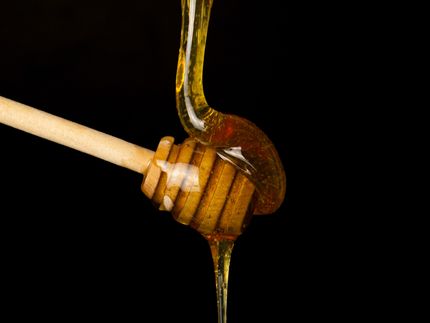Tart, sour, or sweet?
Virginia Tech researchers create hard cider lexicon for accurate, shared descriptions
Citrus, caramelized sugar, vinegary, puckering, sour, and solvent. These are just a handful of the 33 terms that researchers in the Virginia Tech College of Agriculture and Life Sciences found after conducting a sensory descriptive analysis of hard cider.
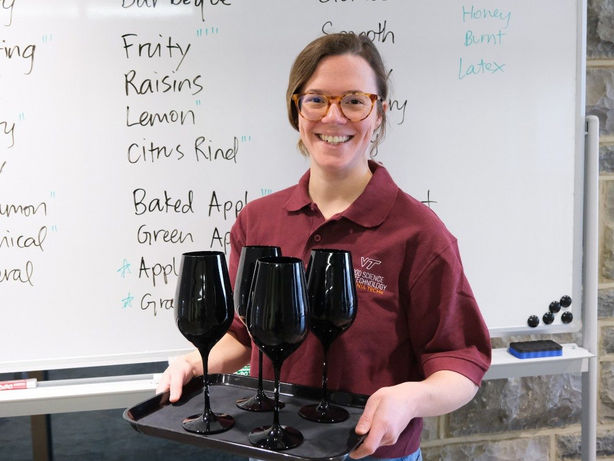
Humans can experience upwards of 10,000 unique aromas in both food and beverage, and Martha Calvert ran a study to narrow down that number for hard cider.
Photo by Alex Hood for Virginia Tech.
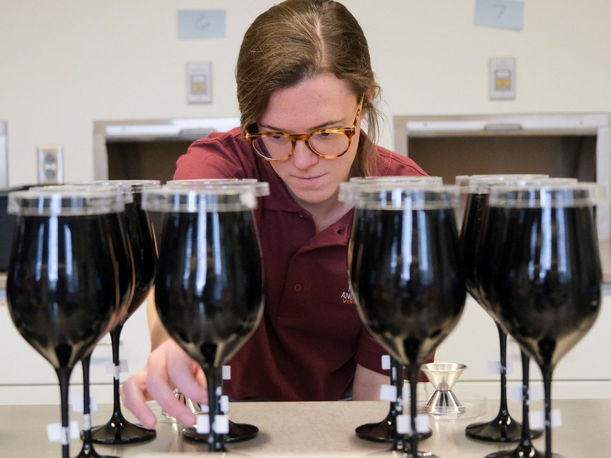
The researchers, which include Jacob Lahne in addition to Martha Calvert (pictured), will conduct a validation study in which the terms are grouped based on similarity.
Photo by Alex Hood for Virginia Tech.
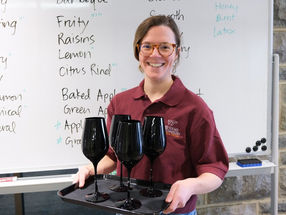
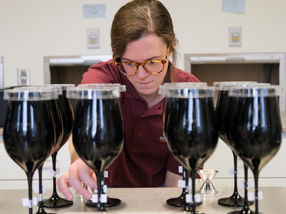
This lexicon didn’t previously exist for hard cider, and its development will aid producers in Virginia’s robust cider industry as well as anyone who chooses to enjoy these beverages. Producers will be able to describe their products with precision and clarity because of the study conducted in the Sensory Evaluation Lab at Virginia Tech.
Humans can experience upwards of 10,000 unique aromas in both food and beverage, which presents a unique challenge to describe the vast wealth of aromas.
“Sensory science” is a field within food science that studies reactions people have to food or beverages and allows for differentiation for the flavors people experience from normal language. This science helps people articulate what they are experiencing, similar to how people describe things they touch or the sounds they hear.
“Because we are minimally trained on using taste and smell, we have a hard time putting a word to a specific taste or smell,” said Martha Calvert, the doctoral student leading the project and graduate research assistant in the Department of Food Science and Technology. “Sensory terms help to distinguish hard cider products and give producers and consumers tools for talking about cider flavors they experience.”
Funded through a USDA grant, the research was published recently in the Journal of Food Science.
Creating the lexicon – or any sensory lexicon – is extremely challenging and requires extensively trained panelists before any tastings occur. This training includes using consumer-inclusive language so that the word bank generated by the panelists is usable by the general public.
To accurately develop the lexicon, all cider tastings were blind, meaning the panelists didn’t know what cider they were drinking. After taking a sip, the panelists would write down every term that could be experienced from that tasting.
“If one was experiencing tart and, another, sour, we would have a group discussion about what the words mean to us and exactly what we are referring to in our heads so we can pick one term,” Calvert said.
Repetitive terms were consolidated to eliminate repeating or closely overlapping words. Then panelists picked words that they felt most reliably and clearly articulated their experiences. For example, the panelists equated sour to the traditional sour patch sensation and vinegary to represent a tart-like sensation.
Of the 33 terms generated, 29 of them varied significantly across the cider samples.
“This means that most of the terms generated are important to describing sensory quality and distinguishing cider products from each other,” Calvert said. “Some of these terms fit broadly into four categories that I called rich, fruity, sour, and funky.”
For rich, think caramelized sugar or butter. Fruity could be grape or apple. Funky could be earthy or metallic, and sour could be the sour patch or vinegar taste.
The researchers, which include Jacob Lahne, an assistant professor in the department and principal investigator of the project, will conduct a validation study in which the terms are grouped based on similarity. Ultimately, the research will be used to generate the cider flavor wheel that both cider producers and consumers will be able to use to help them describe the products that they make and taste.

